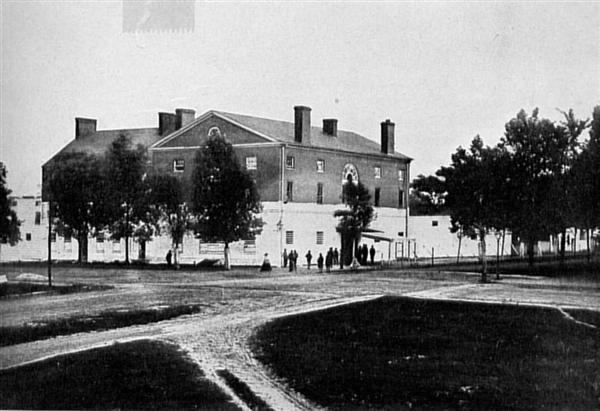The Fifteenth United States Congress was a meeting of the legislative branch of the United States federal government, consisting of the United States Senate and the United States House of Representatives. It met in the Old Brick Capitol in Washington, D.C. from March 4, 1817, to March 4, 1819, during the first two years of James Monroe's presidency. The apportionment of seats in the House of Representatives was based on the Third Census of the United States in 1810. Both chambers had a Democratic-Republican majority.
March 4, 1817: James Monroe became President of the United StatesJuly 4, 1817: Construction on the Erie Canal beganNovember 20, 1817: The first Seminole War began in FloridaJanuary 2, 1819: The Panic of 1819, the first major financial crisis in the United States, began.February 2, 1819: Dartmouth College v. Woodward: Supreme Court allowed Dartmouth to keep its charter and remain a private institution.April 4, 1818: Flag Act of 1818, Sess. 1, ch. 34, 3 Stat. 415April 29, 1817: Rush–Bagot Treaty signed between the U.S. and the United KingdomOctober 20, 1818: Treaty of 1818 between the U.S. and the United Kingdom established the northern boundary as the 49th parallel from the Lake of the Woods to the Rocky Mountains, also creating the Northwest Angle.February 22, 1819: Adams-Onís Treaty: Spain ceded Florida to the United StatesStates admitted and territories created
August 15, 1817: Alabama Territory created by splitting the Mississippi TerritoryDecember 10, 1817: Mississippi admitted as the 20th stateDecember 3, 1818: Illinois admitted as the 21st stateThe count below identifies party affiliations at the beginning of the first session of this congress. Changes resulting from subsequent replacements are shown below in the "Changes in membership" section.
During this congress, two Senate seats were added for each of the new states of Mississippi and Illinois.
During this congress, one House seat was added for each of the new states of Mississippi and Illinois.
President: Daniel D. Tompkins (DR)President pro tempore:John Gaillard (DR), elected March 4, 1817James Barbour (DR), elected February 15, 1819Speaker: Henry Clay (DR)This list is arranged by chamber, then by state. Senators are listed in order of seniority, and Representatives are listed by district.
Skip to House of Representatives, belowSenators were elected by the state legislatures every two years, with one-third beginning new six-year terms with each Congress. Preceding the names in the list below are Senate class numbers, which indicate the cycle of their election. In this Congress, Class 1 meant their term began in the last Congress, requiring reelection in 1820; Class 2 meant their term began with this Congress, requiring reelection in 1822; and Class 3 meant their term ended with this Congress, requiring reelection in 1818.
The names of members of the House of Representatives are preceded by their district numbers.
The count below reflects changes from the beginning of the first session of this Congress.
Lists of committees and their party leaders.
Audit and Control the Contingent Expenses of the SenateClaimsCommerce and ManufacturesDistrict of ColumbiaFinanceForeign RelationsIndian Title to Certain Lands (Select)JudiciaryMilitary AffairsMilitiaMississippi's Admission to the Union (Select)Naval AffairsPensionsPost Office and Post RoadsPublic LandsSeminole War (Select)Slave Trade (Select)WholeAccountsAlabama's Admission to the Union (Select)Arkansas Territory (Select)Bank of the United States (Select)ClaimsCommerce and ManufacturesDistrict of ColumbiaElectionsExpenditures in the Navy DepartmentExpenditures in the Post Office DepartmentExpenditures in the State DepartmentExpenditures in the Treasury DepartmentExpenditures in the War DepartmentExpenditures on Public BuildingsPensions and Revolutionary War ClaimsPost Office and Post RoadsPublic ExpendituresPublic LandsRevisal and Unfinished BusinessRules (Select)Standards of Official ConductWays and MeansWholeEnrolled BillsArchitect of the Capitol:Benjamin H. Latrobe, resigned November 20, 1817Charles Bulfinch, appointed January 8, 1818Librarian of Congress: George WatterstonChaplain:Sereno Edwards Dwight, Congregationalist, elected December 16, 1816William D. Hawley, Episcopalian, elected December 9, 1817John Clark, Presbyterian, elected November 19, 1818Secretary: Charles CuttsSergeant at Arms: Mountjoy BaylyChaplain: Burgess Allison (Baptist)Clerk: Thomas DoughertyDoorkeeper: Thomas ClaxtonSergeant at Arms: Thomas Dunn 
